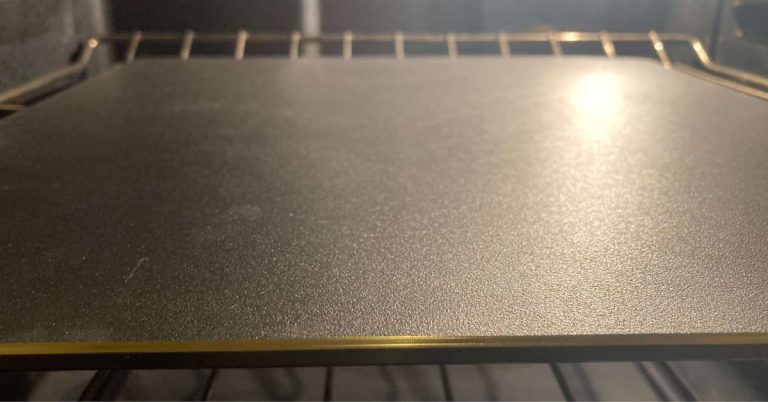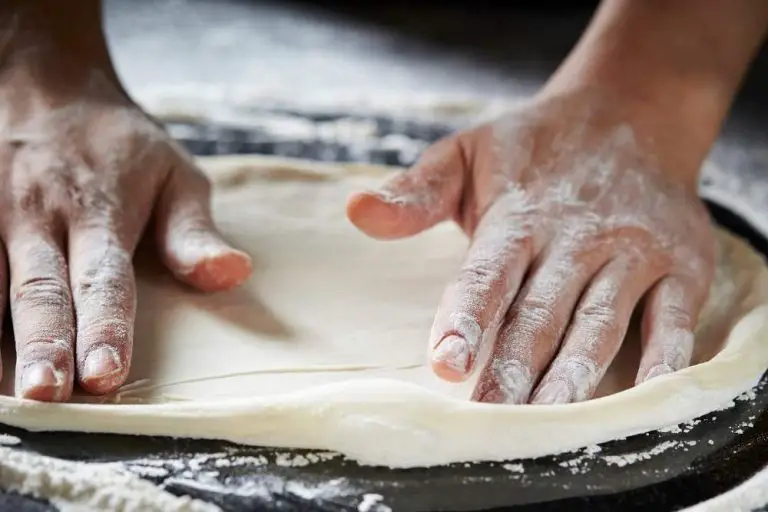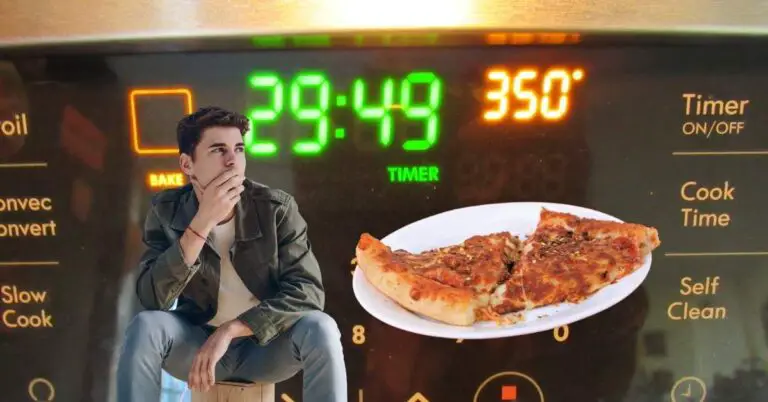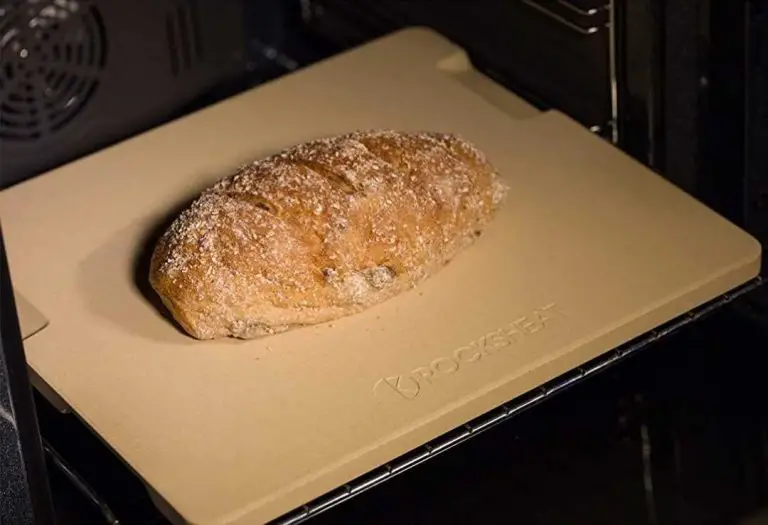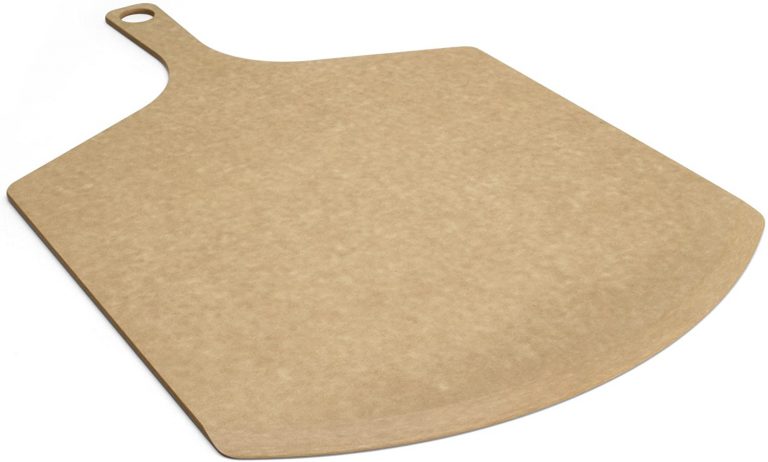Pizza Steel Thickness Guide: Why Girth Matters When It Comes To Homemade Pizza
Making pizza at home is serious business—at least it is for me. This is why I carefully consider the characteristics of every pizza cooking tool I own, including the thickness of my pizza steels.
The thickness of a pizza steel affects how long it takes to preheat, as well as how much heat it can transfer to your pizza crust. For most people using a standard 500F home oven, I recommend a pizza steel thickness of ¼ inches (6.35mm). This thickness to heat ratio is just enough to get a beautifully crispy crust with perfectly cooked toppings.
Most home pizza steels range in thickness from a quarter of an inch to a half an inch (¼” – ½”, 6.35mm – 12.7mm), with the average pizza steel being ¼ inches thick. A thicker pizza steel (½ inch) can retain heat longer and cook more pizzas without reheating in between—though it can overcook the toppings in lower temperature home ovens.
Note: Unless you specifically need a thicker pizza steel, or own a higher temperature home oven, a ¼ inch thick pizza steel will work fine. Just avoid any steel thinner than ¼ inches as these are less heat conductive and prone to warping.
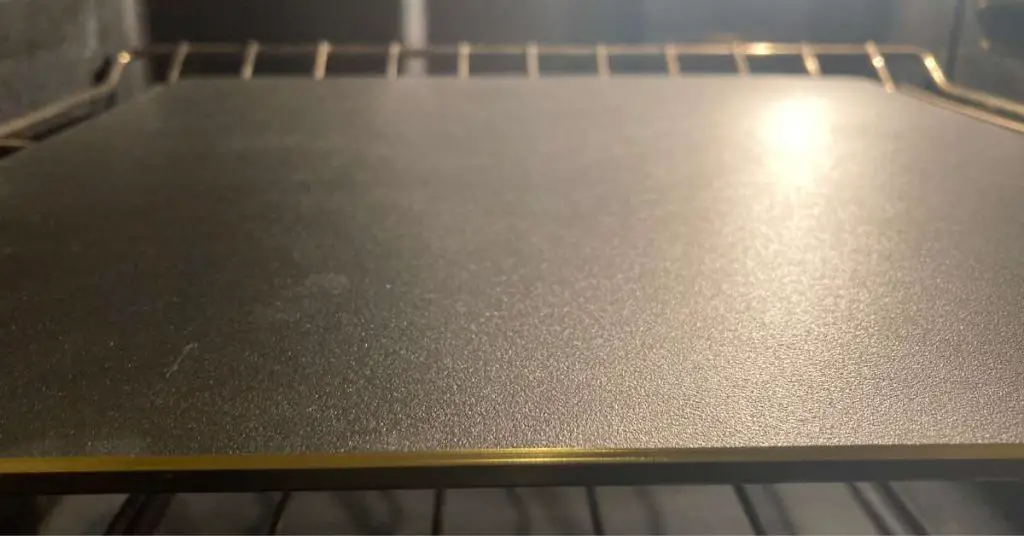
How Pizza Steels Work
A pizza steel is one of the simplest baking tools you can imagine—it’s literally just a slab of stainless steel. These steel slabs are designed to replicate the baking floor of a pizza oven when preheated in your home oven for an extended period of time.
How a pizza steel works is simple: turn on the oven, let the pizza steel preheat for about an hour to absorb all the heat from the oven, then slide your pizza onto it. When the uncooked pizza dough hits the hot steel, it will immediately start to cook and brown.
This is essentially the benefit of a pizza steel. Unlike a pizza cooked on a pan, which goes into the oven cold, a pizza steel allows for the crust to start cooking first. If you’ve ever experienced homemade pizza with an undercooked crust and burnt toppings, a pizza steel is the solution.
Pizza Steel vs Pizza Stone (an aside)
If you’ve heard of pizza stones but not pizza steels, they’re essentially the same thing. The difference with a pizza steel is that it conducts heat much better than a pizza stone. This means pizza steels get hotter faster and stay hotter longer, which results in a better cooked crust.
I’ve had great results using a pizza stone, but it can’t compare to the kind of char and browning I get using a pizza steel. A pizza steel can cook pizza crust fast enough so that the outside is crispy but the inside is still moist and tender, very similar to how a pizza oven works.
Basically, when comparing a pizza stone to a pizza steel, it comes down to the following three factors:
- A pizza steel’s superior heat conduction leads to faster, more even baking.
- The high heat transfer rate results in a crispier crust.
- Steel heats up faster than stone, reducing preheating time.
How Pizza Steel Thickness Affects Pizza Crust
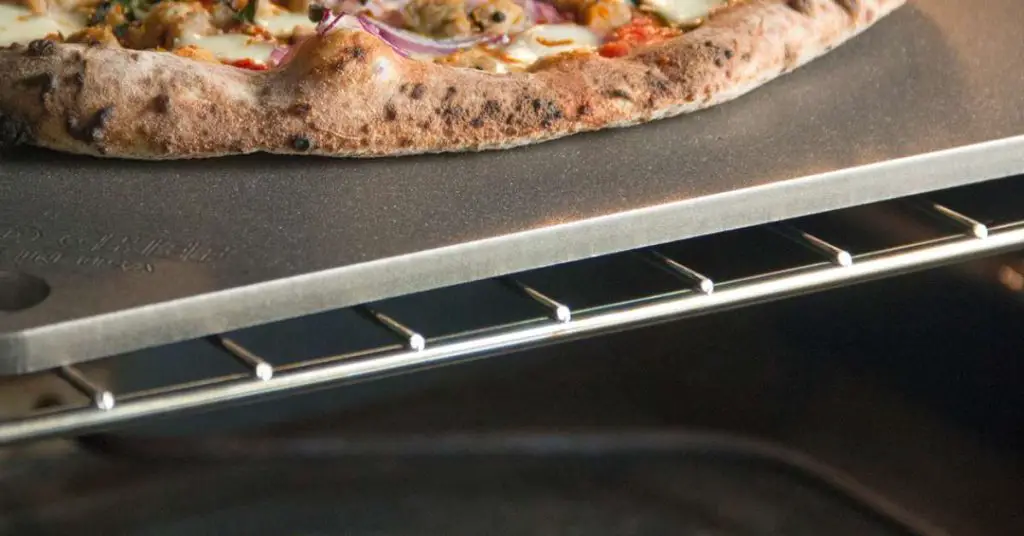
The thickness of your pizza steel can have a big effect on the quality of your pizza crust because a thicker steel is denser and able to store more heat. When you launch your uncooked pizza onto the pizza steel, all that stored heat is transferred directly into the dough and creates a crispy crust with bubbles, browning, and charring.
The thickness of a pizza steel impacts pizza in the following ways:
- Thicker steels store more heat, leading to a faster cook time and a crispier crust.
- The high heat stored in the steel also helps to quickly cook the pizza crust and (indirectly) the toppings as well.
- The quick transfer of heat from the steel to the dough results in the desirable blistering effect on the crust, which you just can’t get with a thinner steel or a regular pizza pan.
How Pizza Steel Thickness Affects Preheating Times
One of the first things you’ll notice when using a thicker pizza steel is that it affects how long it takes to preheat in the oven. The following chart will give you an idea of how long it takes the steel to fully saturate with heat depending on how thick it is:
| Thickness (inches/mm) | Approximate Preheating Time (hours) |
|---|---|
| 1/4 (6.35mm) | 1 hour or more |
| 3/8 (9.525mm) | 1.5 hours or more |
| 1/2 (12.7mm) | 2+ hours |
Having a thicker pizza steel doesn’t just affect the quality of your pizza, it’s also a matter of convenience and energy efficiency. Because a thicker pizza steel is so dense, it takes longer to heat up than a thinner one, but it also retains heat longer and more efficiently.
This means, if you’re making multiple pizzas, you don’t have to wait as long for the steel to preheat before sliding on the next one. The thicker pizza steel also transfers heat more evenly and consistently, so you don’t have to worry as much about hot and cold zones that will leave one side of the pizza crust undercooked.
So, all this means that you will have to wait slightly longer for a thicker pizza steel to preheat, but you’ll be rewarded with a better pizza crust and less downtime between making each pizza.
- Thicker steels take longer to preheat due to their larger mass.
- Once heated, thicker steels retain heat better, maintaining a consistent temperature throughout the cooking process.
- This consistent temperature leads to evenly cooked pizzas, even when baking multiple pizzas consecutively.
Tip: Use an infrared thermometer to figure out exactly when your pizza steel stops getting any hotter. This will tell you the maximum temperature of your pizza steel and how long it takes to preheat in your oven.
Why A Thicker Pizza Steel Is Generally Better
If you don’t care about thermal efficiency and preheating times, it might be tempting to opt for a thinner and lighter pizza steel. But there are actually several reasons why a thicker pizza steel is a better choice all around.
Thicker pizza steels store and transfer heat more efficiently, which results in a better cooked crust. That means if you’re willing to wait an extra 15-20 minutes while it preheats, you can get substantially better results with the thicker steel.
A thicker pizza steel is also more durable and less prone to warping, or suffering from thermal shock, than a thinner less expensive one.
That said, there are some reasons why you might be better off going with a thinner pizza steel. For example, if your oven is small and doesn’t reach temperatures over 400F, then the benefits of a thicker pizza steel are less obvious and you might end up overcooking the bottom of your pizza while the toppings are underdone.
There are also instances where the actual racks in the oven aren’t strong enough to hold the weight of a thicker pizza steel, in which case a thinner lighter pizza steel is obviously preferable. I haven’t personally encountered this issue myself, but if your oven racks are thin and flimsy then this might affect you.
Why thicker pizza steels are better:
- Thicker steels store more heat, allowing for faster baking times and the ability to bake multiple pizzas consecutively.
- Thicker steels are more durable and less prone to warping, making them a long-lasting investment.
- However, depending on your oven’s capabilities and your baking needs, a thinner steel might be sufficient.
Best Thickness For A Pizza Steel
So, with all that said, how thick should a pizza steel be?
If you look at most common pizza steels on the market today, you’ll find that they typically range in thickness from a ¼ to a ½ an inch thick. For most people using a standard 500F home oven, I think a ¼ inch thick (6.35mm) is the sweet that will get you an evenly cooked pizza crust and toppings without having to wait too long for it to preheat.
That said, if your home oven goes up to 550F, you might benefit from an extra thick ⅜ inch to ½ inch (9.5mm – 12.7mm) pizza steel. In hotter home ovens like this, you can allow the pizza steel to get extra hot because the ambient air temperature is high enough that the toppings will cook in time with the crust.
If you’re one of the lucky ones with a home oven that goes over 550F, then you might be a good candidate for a super thick ½ inch thick pizza steel. Just keep in mind that the thicker the pizza steel, the longer it will take to preheat.
But at the end of the day, remember that all we’re looking for is speed and consistency, so pick the right pizza steel for your home oven rather than focusing purely on thickness. For reference, the following chart will give you a good idea about what thickness to look for:
| Ideal Thickness (inches/mm) | Max Oven Temperature |
|---|---|
| 1/4 (6.35mm) | 500F |
| 3/8 (9.525mm) | 550F |
| 1/2 (12.7mm) | 600F and above |
Of course, this is just a rough guide as every home oven radiates heat in a slightly different way. Also, remember that you can still use a thinner pizza steel in a hotter home oven, you’ll just need to adjust your timing and expectations. The same applies for a thicker pizza steel in a less hot home oven.
Best Size For A Pizza Steel
- The size of your pizza steel should be determined by the size of your oven and the size of the pizzas you typically bake.
- Larger, thicker steels can be heavy and difficult to handle and store.
- A standard size that works well for most home ovens is 14×16 inches.
When it comes to the size (or dimensions) of a pizza steel, it all comes down to the size of the oven you’re going to use it in. A pizza steel should fit comfortably on your oven rack without much room to spare to maximize the baking area (and how big you can make your pizza).
That said, make sure to carefully measure your oven before making a purchase to ensure that the oven door will close with your pizza steel on the rack. It’s better to err on the side of caution and get one that’s slightly too small (and usable) than one that’s too big to fit in your oven.
Also, keep in mind that you’ll need a pizza peel in order to slide the uncooked dough onto the pizza steel itself, and the pizza can’t be bigger than the peel. So, if you only have an 11 inch pizza peel, you’ll need to either upgrade the peel to a larger size or opt for a smaller pizza steel.
For the average home oven, I recommend a standard 14×16 inch pizza steel. This gives you room for a standard sized 13 inch pizza with some wiggle room so you don’t have to be too careful when launching your pizza.
If you have a smaller home oven, a square 13×13 inch pizza steel seems to work well, and will give you enough room for a 12 inch Neapolitan sized pizza.
Best Pizza Steels: My Two Top Choices
Now for the part you’ve been waiting for—which pizza steel do I actually recommend?
Fortunately, pizza steels don’t vary that much in terms of actual quality since they’re all essentially made from the exact same stainless steel. So in the end your choice really comes down to thickness and size.
For my home oven, I primarily use two pizza steels: the Ooni Pizza Steel 13 and the Baking Steel Original. Both of these steels are ¼ inch thick, which works perfectly for my 500F home oven.
The Ooni Pizza Steel 13 is a 13×13 inch square, so it works well for Neapolitan style pizza. I also love the smooth edges and slightly rough baking surface which helps conduct heat better.
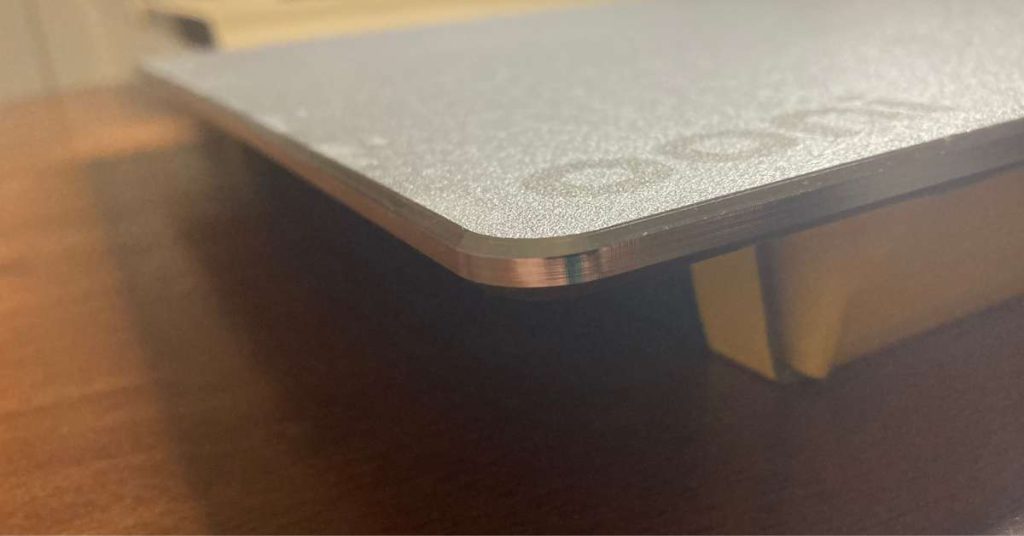
When I want to make a slightly larger pizza, I’ll use my 14×16 inch Baking Steel Original. This pizza steel works amazingly well and is my go-to pizza steel when making pizza in my home oven. It’s not quite as smooth and polished as the Ooni Pizza Steel 13, but it works just as well and costs about the same.
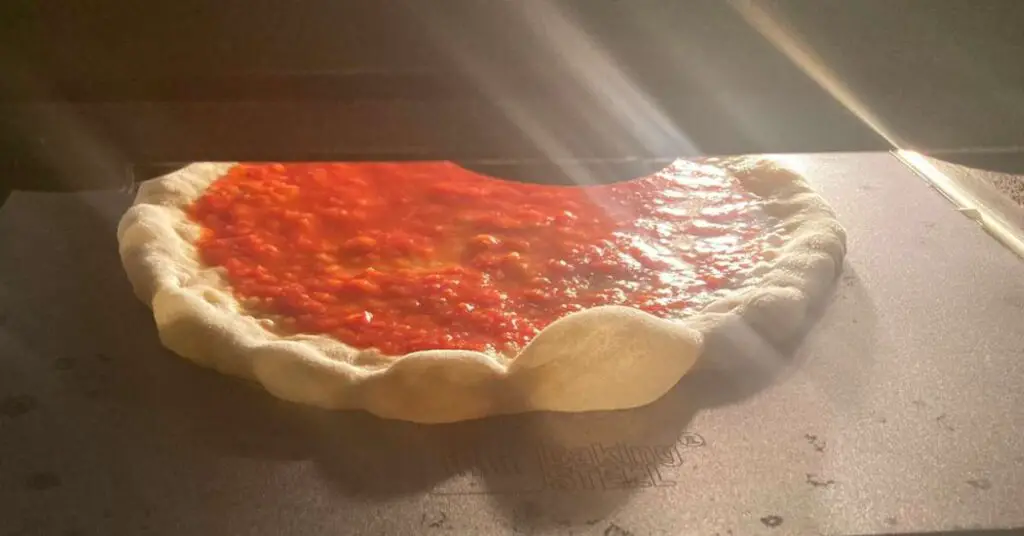
Between these two pizza steels, I think the best choice for most people is the Baking Steel Original. This pizza steel is slightly larger and allows for larger pizzas, plus you don’t have to be as accurate with your launch even when making smaller ones. The price is right in line with most other pizza steels on the market as well.
Other Great Pizza Steel Choices
I gave you the two pizza steels that I use, but there are lots more on the market to choose from that vary in size and thickness.
If you’re looking for a thicker pizza steel for a hotter home oven, NerdChef offers a couple of great choices: the NerdChef Steel Stone Pro, and the NerdChef Steel Stone Ultimate.
Aside from the confusing choice in names (why call it a “steel stone”?), NerdChef makes a great product and their steels are just as good as the two I’ve listed above. Both of these pizza steels are the same size (16×14.25 inches), but the Pro edition is ⅜ inches thick while the Ultimate is a full ½ inches thick.
If you have a high-performance home oven that goes over 550F, I recommend the NerdChef Steel Stone Ultimate. But if your home oven’s temperature is anywhere between 500-550F, you can save some money with the ⅜ inches Pro edition instead.
| Pizza Steel Model | Baking Steel Original | Ooni Pizza Steel | NerdChef Pro | NerdChef Ultimate | Conductive Cooking |
|---|---|---|---|---|---|
| Thickness (inches) | 1/4 | 1/4 | 3/8 | 1/2 | 3/8 |
| Ideal Max Oven Temp | 500F or below | 500F or below | 550F | 600F | 550F |
| Dimensions (inches) | 14×16 | 13×13 | 14.5×16 | 14.5×16 | 16×16 |
| Price | $119 | $99 | $129.95 | $149.95 | $99 |
Final Thoughts
If you’re interested in upping your homemade pizza game, there are few better ways to do this than by buying a pizza steel. That is, unless you’re ready to take the plunge on an outdoor pizza oven (much more expensive).
But choosing the right pizza steel is more than just finding one that’s on sale—you need to consider the maximum temperature and oven rack size of your home oven. A bigger oven can fit a bigger pizza steel and make bigger pizzas. Likewise, a hotter home oven can benefit from a thicker pizza steel.
In either case, opting for a thicker pizza steel at least ¼ inches thick is not only the most energy efficient, it will also give you better results as well. Thicker pizza steel retain heat longer and are better at transferring that heat to uncooked dough, resulting in a crispier crust that cooks faster.
Key Points From This Article:
- The thickness of a pizza steel affects its preheating time and the amount of heat it can transfer to the pizza crust.
- For most people using a standard 500F home oven, a pizza steel thickness of ¼ inches (6.35mm) is recommended.
- A thicker pizza steel (½ inch) can retain heat longer and cook more pizzas without reheating in between, but can overcook the toppings in lower temperature home ovens.
- Pizza steels work by absorbing heat from the oven and transferring it directly to the pizza dough, resulting in a crispy crust.
- Pizza steels are superior to pizza stones due to their superior heat conduction, leading to faster, more even baking and a crispier crust.
- The thickness of a pizza steel impacts the quality of the pizza crust, with thicker steels storing more heat and leading to a faster cook time and a crispier crust.
- Thicker pizza steels take longer to preheat but retain heat better, maintaining a consistent temperature throughout the cooking process.
- Thicker pizza steels are generally better as they store and transfer heat more efficiently, resulting in a better cooked crust. They are also more durable and less prone to warping.
- The ideal thickness for a pizza steel depends on the maximum temperature of your oven. For a 500F oven, a ¼ inch thick steel is recommended, while for a 600F oven, a ½ inch thick steel is recommended.
- The size of your pizza steel should be determined by the size of your oven and the size of the pizzas you typically bake. A standard size that works well for most home ovens is 14×16 inches.
- The Baking Steel Original and the Ooni Pizza Steel 13 are recommended for most people using a standard 500F home oven. For hotter home ovens, the NerdChef Steel Stone Pro and the NerdChef Steel Stone Ultimate are good choices.
Related Questions
Can A Pizza Steel Be Too Heavy?
Occasionally, a pizza steel can be too heavy for your oven. However this usually only happens if you have very flimsy oven racks. Most average home oven racks are more than sturdy enough to support any size pizza steel.


